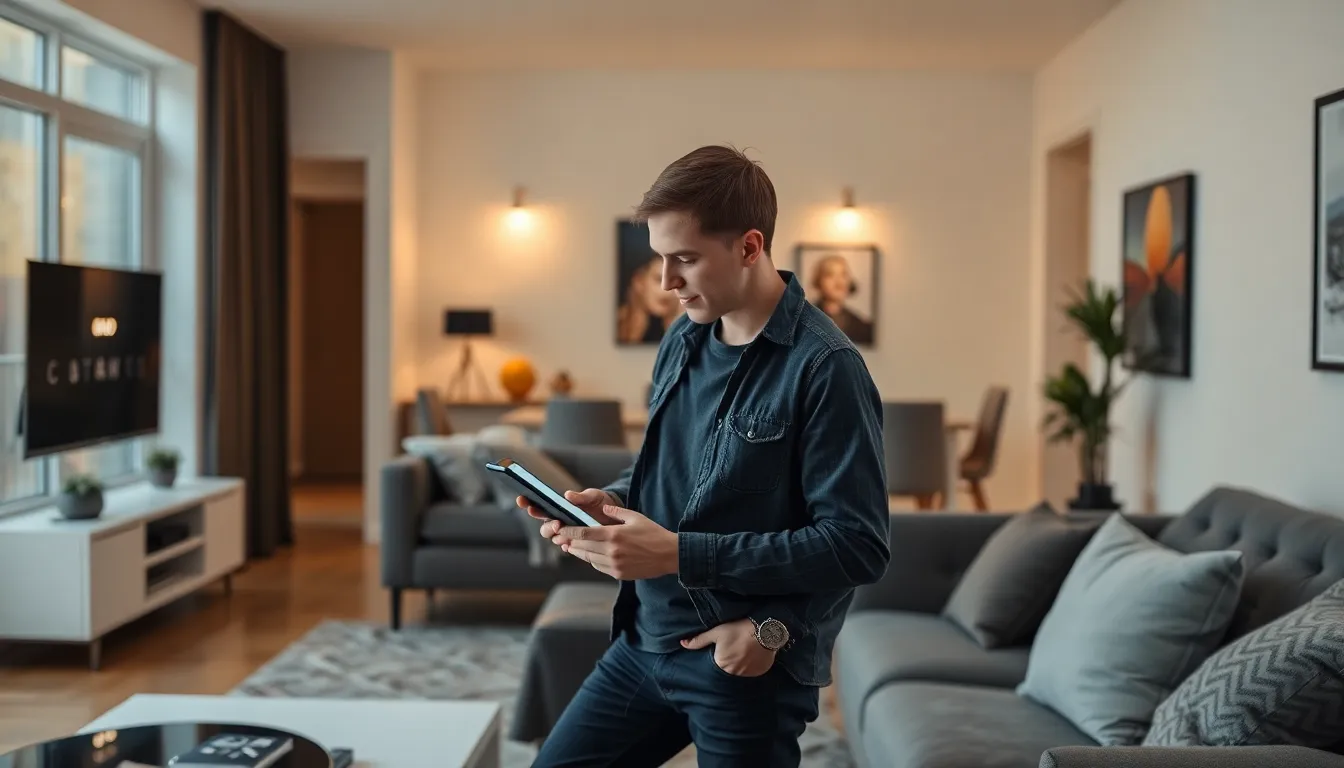Table of Contents
ToggleImagine waking up to the gentle hum of your coffee maker brewing your favorite blend while the blinds automatically rise to greet the morning sun. Home automation systems are no longer just a futuristic dream; they’re the reality that turns everyday living into a seamless experience. With a simple voice command or a tap on your smartphone, your home can become your personal assistant, managing everything from lighting to security.
Overview of Home Automation Systems
Home automation systems enable seamless control of household devices. Users can manage everything from lighting to security features with their smartphones or voice commands. These systems often integrate with various smart devices, creating a connected environment that enhances daily convenience.
Smart lighting solutions allow users to adjust brightness and color based on mood or activity. Automation can program lights to turn on at sunset and mimic presence when no one is home. Voice assistants connect with these systems, turning simple commands into instant actions.
Security is a primary focus in home automation. Cameras and smart locks monitor entrances, providing peace of mind. Alerts notify homeowners of any unusual activity, ensuring safety remains a priority.
Temperature control becomes intuitive through smart thermostats. These devices learn user preferences, optimizing energy consumption and comfort. Homeowners can alter temperature settings remotely, promoting energy efficiency.
Entertainment systems also benefit from automation. Users can synchronize their audio devices to play music throughout the house. Automation can schedule movie nights, dimming lights and setting the perfect ambiance.
Home automation offers customization options, allowing users to create specific scenarios. For instance, a “Good Night” command can lock all doors, turn off unnecessary lights, and lower the thermostat simultaneously. Adaptable interfaces enable adjustments as needs change over time.
Integration of multiple devices enhances the overall experience, creating a cohesive smart home. Home automation systems transform living spaces into efficient, manageable environments, streamlining everyday tasks and improving comfort.
Benefits of Home Automation Systems

Home automation systems provide multiple advantages that contribute to a more efficient and comfortable living environment. These systems enhance daily routines, simplify tasks, and increase overall quality of life.
Enhanced Convenience
Convenience stands out as a primary benefit of home automation systems. Users control various household devices through their smartphone apps or voice commands. Managing tasks such as adjusting lighting, locking doors, or setting the thermostat can occur from anywhere without physical interaction. Many individuals appreciate automated routines, like having lights turn on at specific times or coffee brewed each morning. Customization options allow homeowners to set preferences that align with their lifestyles. Schedules adapt automatically, providing a seamless transition between different activities throughout the day.
Energy Efficiency
Energy efficiency plays a crucial role in home automation systems. Smart devices optimize energy consumption by adapting to user behavior. Thermostats learn preferences, adjusting temperatures based on real-time needs. This capability significantly reduces energy waste, often leading to lower utility bills. Lighting systems can dim or switch off when rooms are unoccupied, further conserving power. Additionally, automation encourages users to monitor their energy usage through detailed reports, promoting conscious consumption habits. Overall, integrating smart devices reduces environmental impact, making homes more sustainable.
Key Components of Home Automation Systems
Home automation systems consist of various components that enhance convenience, security, and energy efficiency in everyday living. Understanding these key components helps users make informed decisions.
Smart Lighting
Smart lighting offers users the flexibility to control brightness and color through apps or voice commands. Some systems allow scheduling for lights to automatically adjust according to sunset or specific routines. Brightness levels can be fine-tuned for different moods or activities, improving ambiance in any room. Additionally, energy-efficient LED bulbs reduce electricity usage while providing vibrant lighting options. With smart lighting, users can create custom scenes, such as a “movie night” setting, to transform their environment easily.
Security Systems
Security systems play a crucial role in home automation, offering peace of mind through advanced monitoring features. Smart cameras provide real-time video feeds and can notify homeowners of unusual activity. Keyless entry systems improve convenience while ensuring security, allowing users to lock or unlock doors remotely. Integration with sensors adds another layer of protection by alerting homeowners to potential intrusions or environmental hazards. Notifications sent directly to smartphones enable quick responses, enhancing overall home security.
Climate Control
Climate control systems enhance comfort and energy efficiency within a home. Smart thermostats adapt to user preferences, learning patterns to optimize heating and cooling settings throughout the day. Remote access allows for adjustments from anywhere, ensuring a welcoming atmosphere upon arrival. Users can also create schedules, programming temperature changes based on occupancy or time of day. In addition to comfort, these systems promote energy savings, reducing overall utility costs while maintaining a pleasant living environment.
Choosing the Right Home Automation System
Selecting a home automation system requires a careful evaluation of budget, compatibility, and features to meet specific needs.
Budget Considerations
Budget plays a crucial role in the choice of home automation systems. Prices vary, with basic setups starting around $100 and advanced systems exceeding $1,000. Identify necessary features before purchasing, as some options may include subscription fees for cloud services. Investing in a system that can scale is wise, as it allows for future upgrades without replacing everything. Setting a budget not only helps in narrowing choices but also ensures long-term satisfaction with the selected system.
Compatibility with Existing Devices
Compatibility with existing devices significantly influences system selection. Many home automation systems are designed to integrate with a range of smart devices from various brands. Ensuring that new systems work seamlessly with current devices saves time and avoids frustrations. It’s beneficial to check compatibility lists provided by manufacturers. Researching brands can reveal which systems offer the best interoperability. Ultimately, a compatible system enhances the overall user experience, making management of home functions smoother.
Future of Home Automation Systems
The future of home automation systems looks promising as technology continues to evolve. Advanced artificial intelligence and machine learning capabilities will drive innovations in smart home devices. Enhanced integration among devices will create a cohesive ecosystem, allowing seamless communication between different systems.
Smart home systems are set to personalize user experiences, adapting automatically to individual preferences. For example, future thermostats may not only learn temperature preferences but also adjust based on weather forecasts. Additionally, voice assistants will likely gain more contextual awareness, responding more accurately to commands and questions.
Data security remains a priority, and advancements in encryption and cybersecurity measures will protect user information. Manufacturers will focus on creating robust security protocols to counter potential threats. The rise of 5G technology will enhance connectivity, resulting in faster response times and smoother operations for smart devices.
Future developments in user interfaces suggest intuitive designs that simplify interactions with smart home systems. Touchless controls and augmented reality interfaces may reshape how users engage with their devices. Homeowners may experience increased automation, with systems anticipating needs—such as preparing the environment for movie night based on calendar events.
Cost-effectiveness is also a factor in shaping the future of home automation. As technology advances, prices are likely to decrease, making smart home systems more accessible. With a growing emphasis on sustainability, energy-efficient technologies will dominate the market, reducing resource consumption and lowering utility bills.
Looking ahead, home automation is expected to transform living spaces into intelligent environments that adapt to everyday life. Smart homes will enhance convenience, security, and efficiency, ultimately elevating the quality of life for individuals and families.
Home automation systems are revolutionizing the way people manage their daily lives. By integrating smart technology into homes, individuals can enjoy unprecedented convenience and efficiency. From automated lighting to advanced security measures, these systems cater to modern lifestyles and enhance comfort.
As technology continues to evolve, the future of home automation promises even greater advancements. Enhanced integration and personalization will redefine user experiences, making homes smarter and more responsive. With a focus on energy efficiency and security, these systems not only simplify tasks but also contribute to sustainable living.
Investing in the right home automation system can lead to a more connected and efficient household. As options expand and prices become more accessible, embracing this technology is increasingly beneficial for homeowners looking to improve their quality of life.


